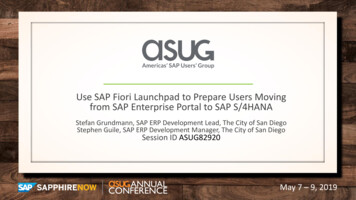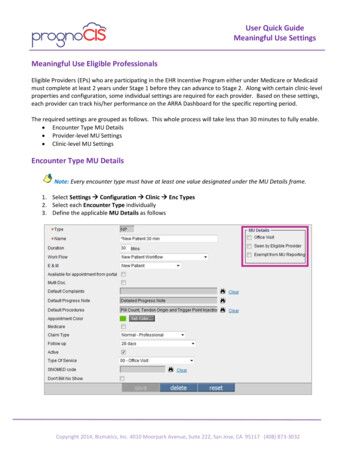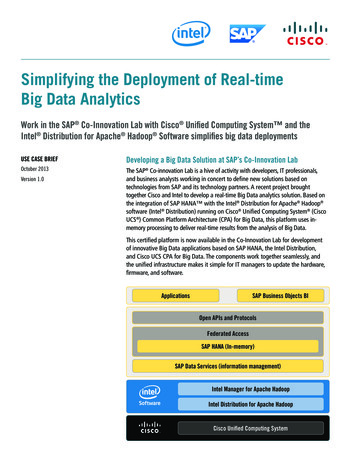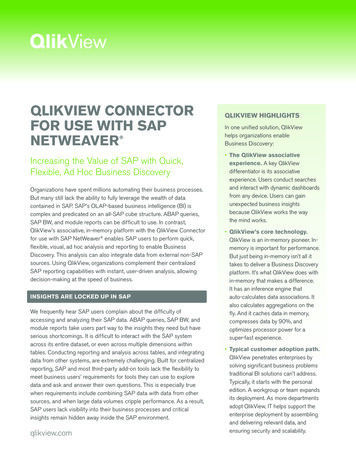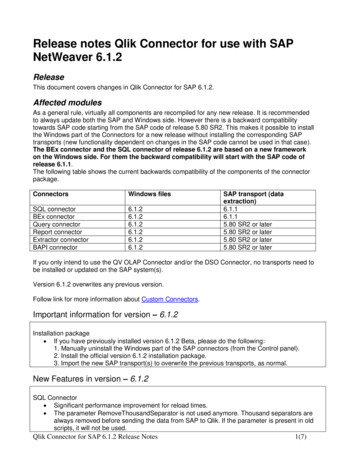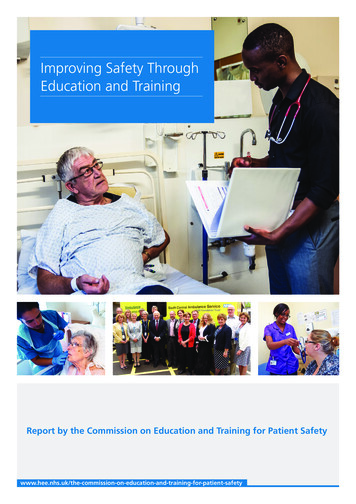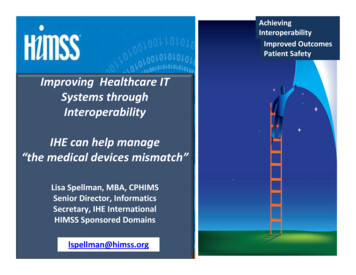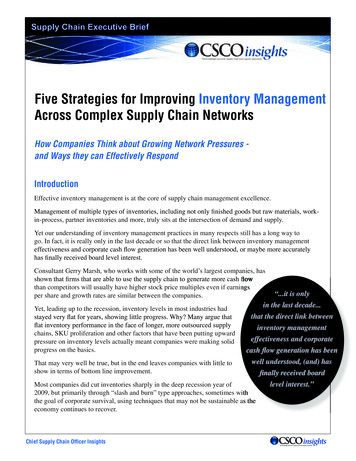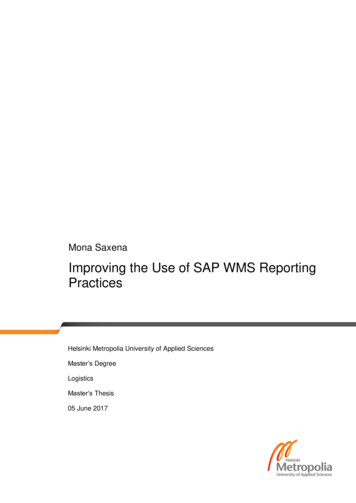
Transcription
Mona SaxenaImproving the Use of SAP WMS ReportingPracticesSubtitleHelsinki Metropolia University of Applied SciencesMaster’s DegreeLogisticsMaster’s Thesis05 June 2017
PrefaceIn autumn 2016, I was eagerly looking forward to a company to do my thesis. With lotsof efforts put towards applying, calling and emailing several companies all aroundFinland, I amazingly managed to do my thesis in a company nearest to my home, whichwas quite a happy, winning situation. While working for my thesis, I managed to learn alot about SAP WMS reporting in particular. Further, it has added to my professionalgrowth by understanding the activities of warehousing in the case company. In fact, Iwas exposed to the fact that the third party logistics providers are used to run a spareparts warehouse. It helped me to learn how a SAP WMS can support in improvingoperations of a warehouse. My colleagues at the case company supported me very welland I can say heartfelt thanks for all their contributions, without those, I could have nevermade it, in the first place.At first, the thesis scope appeared to be very wide for myself. The fact that there wereso many reasons as to why the SAP WMS is used so poorly in the warehouse proved tobe challenge. But gradually, along the way, I realized the focus and started working witha clearer picture. Hence, I would like to sincerely thank Dr. Thomas Rohweder for guidingme through all stages of the study especially while creating the most difficult current stateanalysis. Additionally, I wish to thank PhL Zinaida Grabovskaia, with her encouragingwords, invaluable steering and support during the writing of this thesis. I would be highlymistaken, if I forget to thank my project manager, Mr. Simo Puumalainen who believedin my abilities to do this study and supported me in every possible way despite his busyschedule.Last, but not least, I extend my thanks to my family and classmates for theiroverwhelming encouragement and creating perfect work life balance. Without yourextensive support, this surely would have been a mission impossible!Mona SaxenaEspoo, 05 June 2017
AbstractAuthorTitleNumber of PagesDateMona SaxenaImproving the Use of SAP WMS Reporting Practices86 pages 18 appendices05 June 2017DegreeMasters in LogisticsDegree ProgrammeLogisticsInstructorsDr. Thomas Rohweder, Principal Lecturer, MetropoliaZinaida Grabovskaia, PhL, Senior Lecturer, Head of IndustrialManagement and Logistics Master’s ProgramsMr. Simo Puumalainen, Head of Deliver Service ProcessThis thesis investigates improving the use of SAP Warehouse Management System (WMS)reporting practices in the case company. The management in the case company realized thatthe SAP WMS is not able to provide adequate reports. The management needs reports to beable to monitor the operations of their spare parts warehouse run by a third party logisticsprovider. Overall, management in the case company wants to improve its operative workingpractices.The research method for conducting this thesis was case study. This is due to the fact that thisthesis had its evidence based on the analysis of documents, interviews, discussions andobservations. The researcher was not involved in any real development activities orimplementation. The research design included five steps, where the business challenge wascombined with the current state analysis and the conceptual framework in order to create andfinalize the proposal.As an outcome of the current state analysis, two main challenges were identified to come upwith a conceptual framework and later continue to build a proposal for the case company. Twomain challenges to check the existing knowledge were described as: a) “WHAT” themanagement wants to be reported from SAP WMS (and that is currently missing), b) “HOW”the SAP WMS should be used in order to generate the correct reports for the managers.The final outcome of the study provided an improvement proposal for reporting from SAP WMSin the case company. The proposal identified eight reports that the management needed forreporting. It proposed to use SAP NetWeaver Business Warehouse with SAP Business Objectsfor implementing the reports. It suggested that a barcode scanner integration was a must beforeany report implementation could take place. This is because data related to timestamps wasclearly missing to be able to generate accurate reports. The final proposal was provided withan implementation plan for report generation from the SAP WMS. Last, but not least, the finalproposal for the case company included five recommendations in order to aid reporting fromthe SAP WMS.The final proposal along with its recommendations helps the case company in improving itsuse of SAP WMS for reporting practices. The case company would surely benefit from theresults of this study to create well defined, accurate and structured reports. Good qualityreporting would help to increase efficiency and improve their overall operative practices.KeywordsWarehousing, SAP, WMS, Reporting, Reporting using SAPWMS, SAP NetWeaver Business Warehouse
ContentsPrefaceAbstractTable of ContentsList of FiguresList of Tables12345Introduction11.1Business Context11.2Business Challenge, Objective and Outcome21.3Thesis Outline21.4Key Concepts of the Thesis3Method and Material52.1Research Approach52.2Research Design62.3Data Collection and Analysis Plan9Current State Analysis133.1Key Terms in Warehouse Management System133.2Overview of the CSA Stage183.3Current Use of SAP WMS in the Case Company193.4Roles and Responsibilities Using SAP WMS in the Warehouse253.5Findings from the Current State Analysis (Data Collection 1)263.6Summary of Key Findings and Selected Areas for Improvement35Existing Knowledge on SAP WMS Reporting384.1Brief Overview of SAP and SAP-based WMS384.2Measurements and KPIs Used in Warehousing Management404.3Reporting Functionality in WMS (related to Measurements and KPIs)444.4Conceptual Framework for Improving the Reporting in the SAP WMS49Building Proposal for the Case Company535.153Overview of the Initial Proposal Stage
675.2SAP WMS Reporting Requirements (Data 2)545.3Evaluating the Tools for Producing Reports from SAP WMS595.4Comparison of Tools for Generation of Reports from SAP WMS665.5Proposal Draft68Validation of the Proposal716.1Overview of the Final Proposal Stage716.2Findings of Data Collection 3716.3Summary of Final Proposal736.4Implementation Plan756.5Recommendations to the Case Company76Discussion and Conclusions817.1Summary817.2Evaluation of the Thesis827.3Final Words85ReferencesAppendicesAppendix 1. Interview questions for Espoo office for Data 1 round.Appendix 2. Interview questions for warehouse personnel for Data 1 roundAppendix 3. Summary of interview results from for Data 1 roundAppendix 4: Interview questions for reporting for Data 2 round.Appendix 5. Summary of interview results for Data 2 roundAppendix 6. Test Script for Reports related to Process 2Appendix 7. Test Script for Report related to Process 3Appendix 8. Test Script for Report related to Process 4Appendix 9. Test Scripts for Reports related to Process 5Appendix 10. Summary of Report Generation from SAP WMS for additional processesAppendix 11. Interview questions and responses in the Espoo office for Data 3 round.
List of FiguresFigure 1. Research design of this thesis. . 7Figure 2. Inventory Management in the case company (Internal document: OPAL UserTraining). . 14Figure 3. Structure of IM and WM in the case company (Internal document: OPAL UserTraining). . 15Figure 4. Goods receipt to Purchase Order (PO) using a SAP WMS (Internal document:OPAL User Training). . 19Figure 5. Basic structure for goods movement between warehouses at storage level inthe case company. 20Figure 6. Goods returns process while using SAP WMS (Internal document: OPAL UserTraining). . 22Figure 7. Inventory counting process using SAP WMS (Internal document: OPAL UserTraining). . 23Figure 8. Goods issue as part of outbound logistics using SAP WMS (Internal document:OPAL User Training). . 24Figure 9. Summary of strengths of the current use of SAP WMS in the case company. 26Figure 10. Weaknesses of the current SAP WMS. . 29Figure 11. Summary of weaknesses of the current use of SAP WMS in the casecompany. . 35Figure 12. Features of SAP WMS (SAP Warehouse Management System, 2017). . 39Figure 13. SAP WMS with business processes integrations (Kappauf, et al., 2012, p.137) . 39Figure 14. Standard analyses of LIS (Kappauf, et al., 2012, p. 271). . 46Figure 15. SAP BW content for logistics key indicators provided by InfoProvider(Kappauf, et al., 2012, p. 270). 47Figure 16. Integration processes between logistics applications and BW to producereports through ‘Query’ (Kappauf, et al., 2012, p. 275). . 48Figure 17. Resulting report with no timestamps for Process 1, Report A (from Table 14). 60Figure 18. Resulting report with no timestamps for Process 1, Report B (from Table 14). 61Figure 19. Resulting report with no timestamps for Process 1, Report C (from Table 14). 62
Figure 20. Logical Information Structures providing standard analysis. . 63Figure 21. Process for warehouse reporting from SAP WMS in the case company. . 77Figure 22. Integrating SAP WMS and barcode scanners (Bartsiewicz, 2016). . 78List of TablesTable 1. Data sources of each round of data collection. . 9Table 2. Details of interviews, discussions and workshops in Data 1-3 rounds. . 10Table 3. List of internal documents for the case company. . 12Table 4. SAP transactions used for goods movements in the WMS. . 21Table 5. Gaps identified in reporting usage by five processes currently served by SAPWMS. 33Table 6. Gaps identified in reporting usage by other processes or activities. . 34Table 7. KPIs identified for reporting usage for Inbound Goods Receipt. . 41Table 8. KPIs identified for reporting for Goods Movements within the Warehouse. . 42Table 9. KPIs identified for Inventory Counting in the Warehouse. 42Table 10. KPIs identified for Goods Returns to the warehouse. . 43Table 11. KPIs identified for goods issue from the warehouse. . 43Table 12. KPIs identified for business use from the warehouse. . 44Table 13. Conceptual Framework of this Study. . 51Table 14. Data 2, Stakeholders requirements and inputs for proposal building (Processes1-5). . 55Table 15. Test Script for generating WMS Report for Process 1, Report A (from Table14). . 60Table 16. Test Script for generating WMS Report for Process 1, Report B (from Table14). . 61Table 17. Test Script for generating WMS Report for Process 1, Report C (from Table14). . 61Table 18. Summary of Report Generation from SAP WMS by using different tools. . 65Table 19. Comparison of several factors for tool decision. . 66Table 20. Proposed Draft for this Study. . 69Table 21. Summary of Feedback received for Initial Proposal. 72Table 22. Final Proposal for this Study. . 74Table 23. Implementation Plan for Report Generation from SAP WMS. . 75Table 24. RACI Matrix for reporting
the SAP WMS is not able to provide adequate reports. The management needs reports to be able to monitor the operations of their spare parts warehouse run by a third party logistics provider. Overall, management in the case company wants to improve its operative working practices. The research method for conducting this thesis was case study. This is due to the fact that this thesis had its .


